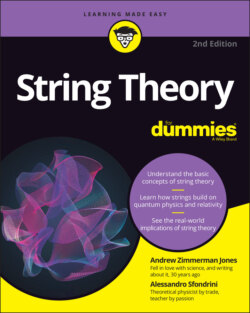Читать книгу String Theory For Dummies - Andrew Zimmerman Jones - Страница 73
The foundation of theory is mathematics
ОглавлениеGalileo famously wrote that the universe is a book, and the language in which it is written is mathematics. Since his time, we have developed more and more powerful mathematical models that represent the underlying physical laws that nature follows. These mathematical models are the actual theories of physics that physicists can then relate to meaningful events in the real world through experiment and other means.
Science requires both experiment and theory to build explanations of what happens in the world. To paraphrase Einstein, science without theory is lame, while science without experiment is blind.
If physics is built on a foundation of experimental observation, then theoretical physics is the blueprint that explains how those observations fit together. The insights of theory have to move beyond the details of specific observations and connect them in new ways. Ideally, these connections lead to other predictions that are testable by experiment. String theory has not yet made this significant leap from theory to experiment.
A large part of the work in theoretical physics is developing mathematical models — frequently including simplifications that aren’t necessarily realistic — that can be used to predict the results of future experiments. When physicists “observe” a particle, they’re really looking at data that shows a specific trace of that particle’s existence. When they look into the heavens, they receive energy readings that fit certain parameters and explanations. To a physicist, these aren’t “just” numbers; they’re clues to understanding the universe.
High-energy physics (which includes string theory and the physics of fundamental particles) has an intense interplay between theoretical insights and experimental observations. Research papers in this area fall into one of four categories:
Experiment
Lattice (computer simulations)
Phenomenology
Theory
Phenomenology is the study of phenomena (no one ever said physicists were creative when it comes to naming conventions) and relating them within the framework of an existing theory. In other words, scientists focus on taking the existing theory and applying it to the existing facts or building models describing anticipated facts that may be discovered soon. Then they make predictions about the experimental observations that should be obtained. (Of course, phenomenology has a lot more to it, but this is the gist of what you need to know to understand it in relation to string theory.) It’s an intriguing discipline, and one that over the last decades has been focusing on supersymmetry and string theory. When we discuss how to possibly test string theory in Chapter 14, it’s largely the work of phenomenologists that tells scientists what they’re looking for.
Though scientific research can be conducted with these different methods, there is certainly overlap. Phenomenologists can work on pure theory and can also, of course, prepare a computer simulation. Also, in some ways, a computer simulation can be viewed as a process that’s both experimental and theoretical. But what all these approaches have in common is that the scientific results are expressed in the language of science: mathematics.
